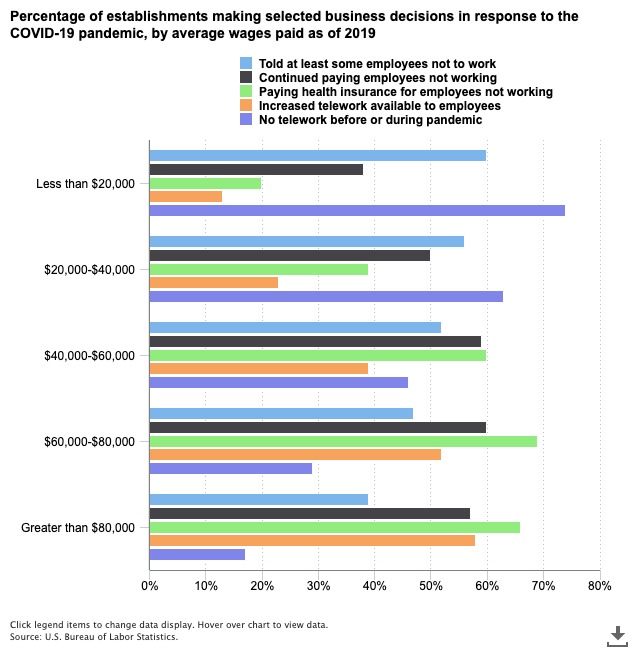New BLS survey data shows how businesses responded to Covid-19
Earlier today, the Bureau of Labor Statistics (BLS) published the results of their survey on how businesses responded to Covid-19. The survey was conducted between July and September 2020 and covered 150,000 establishments, for 7 different questions. The results reveal what we already know; low-income employees have been the most heavily affected during the Covid-19 crisis.
According to BLS
Many U.S. businesses have changed their operations and employment because of the COVID-19 pandemic. Since January 1, 2020, 60 percent of establishments in which workers were paid an average annual wage of less than $20,000 in 2019 told at least some employees not to work. This compared with 17 percent of establishments paying an average wage greater than $80,000. Among establishments that told at least some employees not to work, 57 percent of those paying greater than $80,000 continued paying at least some workers that they told not to work. This compared with 38 percent for establishments in which workers were paid an average wage less than $20,000.

Additionally,
Establishments in which workers were paid more than $80,000, on average, were more than three times as likely as those paying less than $20,000 to have paid health insurance premiums for employees told not to work. Establishments paying more than $80,000 were more than four times as likely as those paying less than $20,000 to report increasing telework opportunities for workers. Telework was not available before or during the pandemic in 74 percent of establishments that paid workers less than $20,000, on average. This compared with 17 percent of establishments in which workers were paid more than $80,000.
Low-income jobs are heavily concentrated in the service sector
There is a combination of factors that contributed to this discrepancy. Among those are the following;
(1)Low-paying jobs are concentrated in the service industry which was bombarded by shutdowns.
(2)A potential reduction in business due to social distancing or fear of infection reduced the need for labor in the affected low-income businesses.
(3)Businesses with Low paying jobs are located in in-persons service jobs reducing the opportunity for telework
(4)Businesses with high paying jobs are concentrated in industries whose revenue was not affected by covid-19 or the shutdown.
(5) Businesses with Low paying jobs had a little financial cushion to cover their payroll expenses after reduced business due to the crisis.
In Minnesota for instance, we have seen the relentless shutdown efforts that have been targeted towards restaurants and bars as well as other establishments in the leisure and hospitality industry. These are all businesses that fit most of the factors above. And workers in those industries continue to be plagued by high unemployment.